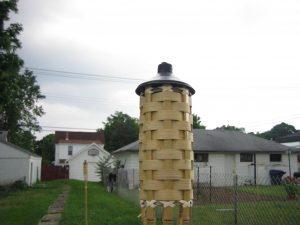 One of my recurring summer jobs, in addition to filling and unfilling the tubes of the Internets, is to adjust the height of the small vertically-oriented plant life that densely covers the land surrounding my house.
One of my recurring summer jobs, in addition to filling and unfilling the tubes of the Internets, is to adjust the height of the small vertically-oriented plant life that densely covers the land surrounding my house.
Many people refer to this act as "cutting the grass."
Over the last few years I've tried quite a wide variety of approaches to and implements for "cutting the grass," and I'd like to share them with you now, because imparting unsolicited and only moderately useful information to a halfway-interested audience is what blogging is all about, no?
- Not mowing the grass at all.
This is the approach I always try first when I move into a new space. As the warm season comes around and the grass gets taller and taller, you can see the land start to return to its natural state, and it's exciting! Unfortunately, I'm often not the only one watching this growth with anticipation, and the neighbors on either side of me are often not as excited as I about the prospect of a rewilded yard. Some have even given me subtle hints about their concern by, oh, say, mowing my yard for me without asking. I do suppose there is utility in being able to walk across some parts of the yard without encountering snakes, dead mice, abandoned vehicles, warning flags placed by the City, etc. So, as a matter of neighborly politeness and practical landscape planning, I've usually been compelled to take on some sort of mowing activity. (A blog post for another time is why we put ourselves in that position in the first place.) - A neighbor's gas powered mower.
It seems kind of silly that in most every garage or tool shed up and down most every street in this country, there sits a mowing device that is used an average of twice a month, and otherwise collects dust and rust. Having been exposed to the clever practice that some people refer to as "sharing," for a while I decided to try "sharing" a neighbor's gas powered mower with them. It was generally successful - I would just call and make sure it was okay to pick up, pick it up and gas it up, and use it, and return it. I won't go into the details of why this "sharing" system became insufficient for my needs, but eventually I did decide that I had to break down and get my own mowing device. - My own gas powered mower.
Oh, wow, there's nothing like it is there? Pour a little dinosaur juice in a hole, crank that puppy up, and you're wreaking havoc on that grass left and right. Let me show you exactly how tall you're going to be, little plants! Oh, and the smell! - oh, wait, no, that's kind of gross since it's that gas smell. But the sounds! Oh, wait, no, it's actually kind of annoying and loud, and especially if you're a neighbor trying to enjoy your back porch or have dinner or sleep in or meditate. But the energy efficiency! All we have to do is drill deeply enough in the Earth to convert ancient sunlight from millions of years ago into a highly flammable substance, truck it across thousands of miles, and sell it to each other all so that we don't have to put too much physical effort into carving up the plant life that we voluntarily arranged around our living spaces.Oh wait, maybe there's a better way.
- The scythe.
I asked myself, "how did people mow their yards before there were lawn mowers?" The answer (when it wasn't, "they didn't") was "with a scythe." I read about the amazing, almost meditative practice of standing in the grass, quietly whisking a scythe blade back and forth around you, falling the grass quickly and peacefully. It sounded great, and I decided I wanted to try using a scythe to mow my yard. I had one custom-built for me by the amazing craftsman at Scythe Supply, located in Maine. I was giddy with excitement when it came and while I put it together, and then I realized, I have absolutely no idea how to use this thing. I read up on scythe usage on the Internet, and I read the book that came with it, and that was definitely helpful. I tried my best to put it into practice, and did quite a number on my yard in the process. Somehow "Figure 4-1" wasn't happening. I tried it a few more times, doing my best to keep from turning red as the neighbors looked on at the crazy guy with the death blade next door, but the rhythmic cutting motion didn't come to me. I realized that this simple but useful knowledge - how to cut grass with a scythe - was something I would need to learn in person from someone who already knew how to do it. And then I realized that the number of people with that knowledge in my area is probably minimal, and the psychological barriers to using my scythe built up from there. I still want to learn how to use it for real, but after a long week and a unruly yard staring me down, I haven't found the patience for that yet.
I was giddy with excitement when it came and while I put it together, and then I realized, I have absolutely no idea how to use this thing. I read up on scythe usage on the Internet, and I read the book that came with it, and that was definitely helpful. I tried my best to put it into practice, and did quite a number on my yard in the process. Somehow "Figure 4-1" wasn't happening. I tried it a few more times, doing my best to keep from turning red as the neighbors looked on at the crazy guy with the death blade next door, but the rhythmic cutting motion didn't come to me. I realized that this simple but useful knowledge - how to cut grass with a scythe - was something I would need to learn in person from someone who already knew how to do it. And then I realized that the number of people with that knowledge in my area is probably minimal, and the psychological barriers to using my scythe built up from there. I still want to learn how to use it for real, but after a long week and a unruly yard staring me down, I haven't found the patience for that yet. - A human powered push mower.
Ding ding ding - we have a winner. This is the technology that I guess emerged post-scythe and pre-gas mower. You know what I'm talking about, right - it's the cylindrical blades that rotate around as you push the mower device, trapping the grass between the blade and another plate, slicing it off. They're quiet, mostly effective, and (for my yard anyway) a good balance of appropriate physical effort and time efficiency. They should generally last many years without maintenance or sharpening, and they don't take up much space at all. I settled on the Scotts 2000 Classic model, which has a 20" deck on it. You know this last size detail is a big deal because it is written in italics on the box AND on the mower itself. It's taken me around 45 minutes to mow my current yard with a gas mower, and tonight it took me 50 minutes to put the Scotts 2000 together AND mow. ("Ah," you say, "we're being subjected to this blog post because you happened to mow your yard tonight? Get a life!")Anyway, I know that not everyone can take the time to use a push mower, but if you can at least see all of your yard from one place without needing to walk for a mile, or even if you can't and just want some more quiet outdoors time, I recommend it.
Okay, that's my mowing history. I welcome your comments, suggestions, alternate realities, etc. If you want to try out any of these implements or strategies (remember, "sharing") just let me know. And remember, ask about someone's mowing history before you get too close to them (and especially before you mow together) - it could save you a lot of heartache later.
 I’m a journalist, publisher, software developer and entrepreneur with experience as a founder and organizational leader. Work with me or learn more about me.
I’m a journalist, publisher, software developer and entrepreneur with experience as a founder and organizational leader. Work with me or learn more about me.

I admire your favorite technique, but you didn't cover at least one other option: installing more vertically oriented plant life that will take the place of grass. Each spring I like to rip up a small patch of grass and replace it with hostas, boxwood, azaleas, river rock, mulch, etc. In another 10 years or so I won't have any grass at all, which suits me just fine.
I'll "share" my yard with you Chris, if you want to give your new mower a workout! We also have a version 1.0 scythe and plenty of fields with no nearby neighbors, if you want to practice. 😉
I had a reel mower and tried to make it work but my lawn is so lumpy (dumb landlord...grrr) that I had to get a gas powered mower instead. Fortunately I like long grass, so one gallon of gas has lasted the entire season.
AND .... lawn idea: there are patches of Very Interesting Grasses (VIGs) growing here and there in my lawn -- I've started mowing around them to create Very Interesting Vertical Grass Spots (VIVGSs)in my lawn. Cuts down on mowing surface area! Yahoo. Fun with lawnmowers.
I agree with Alex -- I see grass as wasted space; it's a weed that has somehow become socially acceptable (expected, even!)
We routinely use black plastic sheeting to kill off swaths of grass, then dig up the soil and plant vegetables or flowering plants there instead. Our yard looks pretty unruly, but it's VERY alive and looks exciting (sort of the sensation you'd get from seeing #1, except in a more useful context)
If you want minimal maintenance, go for flowering plants or herbs -- if you want to really put the space to work, get some veggies in there, maybe some trellises, etc. I like low-work/high-yield plants like tomatoes, pole beans, cucumber and zucchini. Peppers are nice too, but don't yield quite as much. 🙂
Jean -- I like your idea, we should try that in our front yard. Do you put rocks around your VIVGSs to further accentuate them?
Mowing season is almost over, but several of my neighbors are not mowing their back yards and/or are mowing them less frequently. They keep their front yards mowed. (I know this because I can see their back yards from the alley I drive down every day). I can only assume the price of gas has something to do with it as more people are mowing this year than last year.
Loved your blog, very funny and actually helpful
Just as you say, it is not easy getting onto the way of a scythe. I have written a description on how to use a scythe at http://scythephotographs.weebly.com/how-to-use-a-tyzack-patent-blade-type-scythe.html
The scythe that I use has a blade that is much harder that yours and requires a different maintenance procedure but you might find some useful tips anyway.